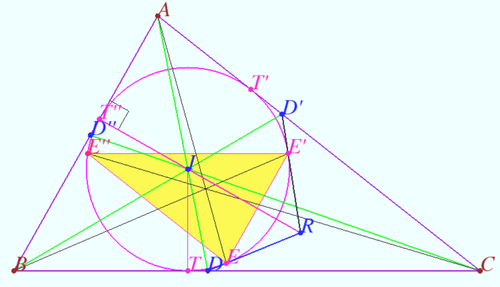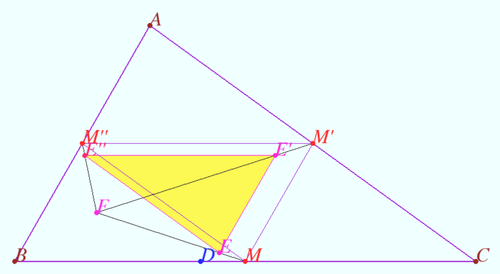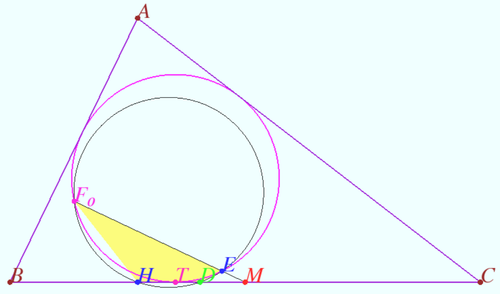Difference between revisions of "Feuerbach point"
(→Sharygin’s prove) |
(→Sharygin’s prove) |
||
| Line 1: | Line 1: | ||
The incircle and nine-point circle of a triangle are tangent to each other at the Feuerbach point of the triangle. The Feuerbach point is listed as X(11) in Clark Kimberling's Encyclopedia of Triangle Centers and is named after Karl Wilhelm Feuerbach. | The incircle and nine-point circle of a triangle are tangent to each other at the Feuerbach point of the triangle. The Feuerbach point is listed as X(11) in Clark Kimberling's Encyclopedia of Triangle Centers and is named after Karl Wilhelm Feuerbach. | ||
| − | ==Sharygin’s | + | ==Sharygin’s proof== |
<math>1998, 24^{th}</math> Russian math olympiad | <math>1998, 24^{th}</math> Russian math olympiad | ||
[[File:Feuerbach 1.png|500px|right]] | [[File:Feuerbach 1.png|500px|right]] | ||
| − | + | ===Claim 1=== | |
| − | |||
Let <math>D</math> be the base of the bisector of angle A of scalene triangle <math>\triangle ABC.</math> | Let <math>D</math> be the base of the bisector of angle A of scalene triangle <math>\triangle ABC.</math> | ||
| Line 26: | Line 25: | ||
<math>AE, BE', CE''</math> are concurrent at the homothetic center of <math>\triangle ABC</math> and <math>\triangle EE'E''.</math> | <math>AE, BE', CE''</math> are concurrent at the homothetic center of <math>\triangle ABC</math> and <math>\triangle EE'E''.</math> | ||
| − | + | ===Claim 2=== | |
[[File:Feuerbach 2.png|500px|right]] | [[File:Feuerbach 2.png|500px|right]] | ||
Let <math>M, M',</math> and <math>M''</math> be the midpoints <math>BC, AC,</math> and <math>AB,</math> respectively. Points <math>E, E',</math> and <math>E''</math> was defined at Claim 1. | Let <math>M, M',</math> and <math>M''</math> be the midpoints <math>BC, AC,</math> and <math>AB,</math> respectively. Points <math>E, E',</math> and <math>E''</math> was defined at Claim 1. | ||
| Line 54: | Line 53: | ||
Therefore <math>MH \cdot MD = MT^2 = ME \cdot MF \implies</math> points <math>F, E, D,</math> and <math>H</math> are concyclic. | Therefore <math>MH \cdot MD = MT^2 = ME \cdot MF \implies</math> points <math>F, E, D,</math> and <math>H</math> are concyclic. | ||
| + | ===Claim 3=== | ||
| + | [[File:Feuerbach 3.png|500px|right]] | ||
| + | Let <math>H</math> be the base of height <math>AH.</math> Let <math>F_0 = ME \cap \omega \ne E.</math> | ||
| + | Prove that points <math>F_0, E, D,</math> and <math>H</math> are concyclic. | ||
| + | |||
| + | <i><b>Proof</b></i> | ||
| + | |||
| + | <math>MT</math> tangent to <math>\omega \implies MT^2 = ME \cdot MF_0.</math> | ||
| + | Denote <math>a = BC, b = AC, c = AB.</math> | ||
| + | <cmath>BD = \frac {ac}{b+c}, BM = \frac {a}{2} \implies MD = \frac {a(b-c)}{2(b+c)}.</cmath> | ||
| + | <cmath>BT = \frac {a+c-b}{2} \implies MT = \frac {b-c}{2}.</cmath> | ||
| + | Point <math>H</math> lies on radical axis of circles centered at <math>B</math> and <math>C</math> with the radii <math>c</math> and <math>b,</math> respectively. So <math>BH = \frac {a}{2} - \frac {b^2 – c^2}{2a} \implies HM = \frac {b^2 – c^2}{2a}.</math> | ||
| + | Therefore <math>MH \cdot MD = MT^2 = ME \cdot MF_0 \implies</math> points <math>F_0, E, D,</math> and <math>H</math> are concyclic. | ||
Revision as of 08:32, 29 December 2023
The incircle and nine-point circle of a triangle are tangent to each other at the Feuerbach point of the triangle. The Feuerbach point is listed as X(11) in Clark Kimberling's Encyclopedia of Triangle Centers and is named after Karl Wilhelm Feuerbach.
Sharygin’s proof
![]() Russian math olympiad
Russian math olympiad
Claim 1
Let ![]() be the base of the bisector of angle A of scalene triangle
be the base of the bisector of angle A of scalene triangle ![]()
Let ![]() be a tangent different from side
be a tangent different from side ![]() to the incircle of
to the incircle of ![]() is the point of tangency). Similarly, we denote
is the point of tangency). Similarly, we denote ![]() and
and ![]()
Prove that ![]() are concurrent.
are concurrent.
Proof
Let ![]() and
and ![]() be the point of tangency of the incircle
be the point of tangency of the incircle ![]() and
and ![]() and
and ![]()
Let ![]() WLOG,
WLOG, ![]()
![]()
![]()
![]() Similarly,
Similarly, ![]() points
points ![]() and
and ![]() are symmetric with respect
are symmetric with respect ![]()
Similarly, ![]()
![]() are concurrent at the homothetic center of
are concurrent at the homothetic center of ![]() and
and ![]()
Claim 2
Let ![]() and
and ![]() be the midpoints
be the midpoints ![]() and
and ![]() respectively. Points
respectively. Points ![]() and
and ![]() was defined at Claim 1.
was defined at Claim 1.
Prove that ![]() and
and ![]() are concurrent.
are concurrent.
Proof
![]()
![]()
![]() are concurrent at the homothetic center of
are concurrent at the homothetic center of ![]() and
and ![]()
Claim 3
Let ![]() be the base of height
be the base of height ![]()
Prove that points ![]() and
and ![]() are concyclic.
are concyclic.
Proof
![]() tangent to
tangent to ![]()
Denote ![]()
![]()
![]() Point
Point ![]() lies on radical axis of circles centered at
lies on radical axis of circles centered at ![]() and
and ![]() with the radii
with the radii ![]() and
and ![]() respectively. So
respectively. So ![]()
Therefore ![]() points
points ![]() and
and ![]() are concyclic.
are concyclic.
Claim 3
Let ![]() be the base of height
be the base of height ![]() Let
Let ![]() Prove that points
Prove that points ![]() and
and ![]() are concyclic.
are concyclic.
Proof
![]() tangent to
tangent to ![]() Denote
Denote ![]()
![]()
![]() Point
Point ![]() lies on radical axis of circles centered at
lies on radical axis of circles centered at ![]() and
and ![]() with the radii
with the radii ![]() and
and ![]() respectively. So
respectively. So ![]() Therefore
Therefore ![]() points
points ![]() and
and ![]() are concyclic.
are concyclic.












